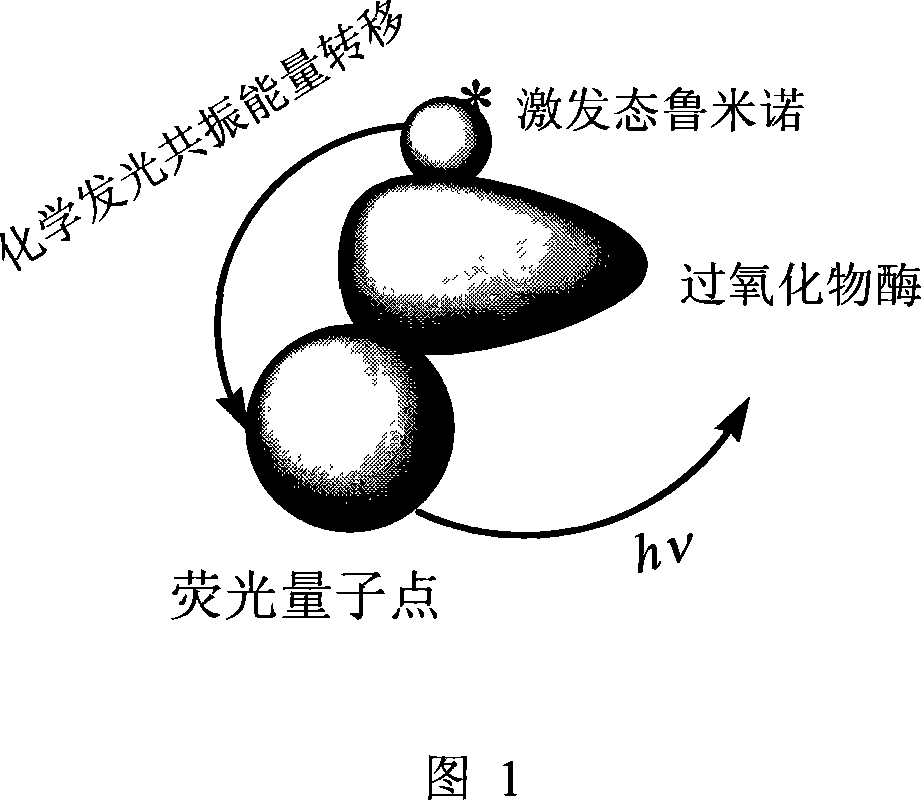Process of constructing nanometer biological device based on chemiluminescent resonant energy transfer principle
A technology of resonance energy transfer and biological nanotechnology, which is applied in the fields of chemiluminescence/bioluminescence, biological testing, and analysis through chemical reactions of materials, etc. In order to solve the problems of expensive equipment and other problems, it achieves the effects of low cost, easy operation, good water solubility and stability
- Summary
- Abstract
- Description
- Claims
- Application Information
AI Technical Summary
Problems solved by technology
Method used
Image
Examples
Embodiment 1
[0023] (1) Preparation of sodium telluride hydride
[0024] Put 80 milligrams of tellurium powder, 80 milligrams of sodium borohydride and 2 milliliters of water in a 10 milliliter small flask, and immediately seal the mouth of the small reaction flask with a rubber stopper, and react at room temperature for 8 hours. Carefully transfer the supernatant in the flask to a 100 ml flask filled with degassed ultrapure water to prepare a 0.00625 mol / L sodium telluride hydride solution.
[0025] (2) Microwave Aqueous Mercaptopropionic Acid Assisted Synthesis of CdTe Quantum Dots
[0026] Mix 0.00125 mol / L cadmium chloride and 0.003 mol / L mercaptopropionic acid to form a solution, adjust the pH value to 8.0 with sodium hydroxide solution, pass nitrogen gas to remove oxygen for 30 minutes, stir vigorously and under the protection of nitrogen gas , inject sodium hydride telluride solution to form cadmium telluride monomer solution. The molar ratio of added divalent cadmium ions: sodium...
Embodiment 2
[0030] (1) The preparation of sodium telluride hydride is as described in Example 1.
[0031] (2) Aqueous phase synthesis of glutathione-modified CdTe quantum dots
[0032] Using water as a solvent, mix cadmium chloride with a concentration of 0.00125 mol / L and 0.0025 mmol / L glutathione, adjust the pH value of the solution to 9.0, and then inject 0.00625 mol / L sodium telluride hydride at a temperature of 25 degrees Celsius The mixture was stirred for 10 minutes to obtain a cadmium telluride precursor solution. The cadmium telluride precursor solution is heated at 80 degrees centigrade for 1-20 hours to obtain different quantum dots with a light emission range of 480-650 nanometers.
[0033] (3) Preparation of glutathione-modified cadmium telluride quantum dots-peroxidase bionanodevices
[0034] Will contain 2 x 10 -6 mol / L glutathione-modified CdTe quantum dots, 1×10 -3 Mole / L ethyl[3-(dimethylamino)propyl]carbodiimide hydrochloride and 1×10 -6 The mol / L peroxidase is add...
Embodiment 3
[0036] (1) The preparation of sodium telluride hydride is as described in Example 1.
[0037] (2) Aqueous Phase Synthesis of HgCdTe Quantum Dots
[0038] Dissolve 0.00125 mol / L cadmium chloride and 0.0025 mol / L mercuric chloride in 90 ml of ultrapure water, add 0.00625 mol / L mercaptopropionic acid and adjust the pH value to 10.0, inject 0.00625 mol / L tellurium 10 milliliters of sodium hydride solution, at this moment obtain mercury cadmium telluride precursor solution, and solution is orange-yellow. The solution was put into a microwave reactor for reaction, and heated at 130° C. for 30 minutes to obtain near-infrared mercury cadmium telluride quantum dots with a fluorescence emission peak at 800 nanometers and a quantum yield of 20%.
[0039] (3) Preparation of cadmium mercury telluride quantum dots-peroxidase bionanodevices
[0040] will contain 5 x 10 -5 mol / L mercaptopropionic acid modified cadmium mercury telluride quantum dots, 2.5×10 -3 Mole / liter of ethyl[3-(dimeth...
PUM
| Property | Measurement | Unit |
|---|---|---|
| emission peak | aaaaa | aaaaa |
Abstract
Description
Claims
Application Information
 Login to View More
Login to View More - R&D
- Intellectual Property
- Life Sciences
- Materials
- Tech Scout
- Unparalleled Data Quality
- Higher Quality Content
- 60% Fewer Hallucinations
Browse by: Latest US Patents, China's latest patents, Technical Efficacy Thesaurus, Application Domain, Technology Topic, Popular Technical Reports.
© 2025 PatSnap. All rights reserved.Legal|Privacy policy|Modern Slavery Act Transparency Statement|Sitemap|About US| Contact US: help@patsnap.com


